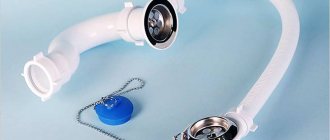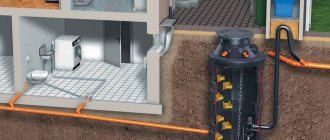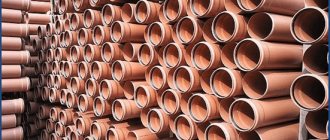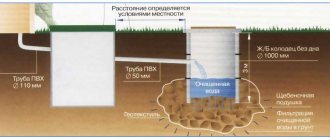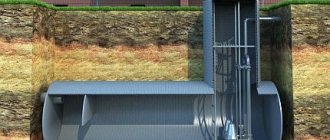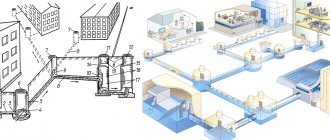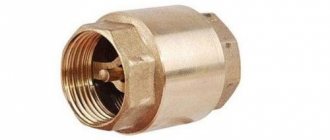A siphon is needed both to protect against blockages and as a barrier that prevents odors from the sewer system from penetrating into the room. Its design is based on the principle of a water seal, that is, liquid always remains in it. Due to this, the air in the room is separated from the sewer air, but the waste flows freely.
Siphons are available in a wide variety of types, sizes and shapes, and it can be difficult to navigate their variety. This text will make your choice easier - it briefly discusses the main parameters by which you should select a device.
What is a siphon
A siphon is a special device consisting of one or more pipes and containers and is used to connect plumbing fixtures to wastewater disposal systems.
Thanks to its design and bends, it creates a plug between the sewer and the room that is impenetrable for air exchange, preventing the penetration of odors and bacteria into the room. Siphons are used in various rooms, including a kitchen, bathroom, shower stall. They differ from each other in structure, material and drainage overlap, and size. Despite the differences, all types have a similar structure of the main parts, including:
- Frame;
- Pipes;
- Drain;
- Bends;
- Connecting nuts and screws;
- Seals for sealing.
Meaning of the word
The word "siphon" comes from the Greek - tube, pump. It has several different meanings (“Explanatory Dictionary of the Russian Language” by Ushakov):
- A curved tube for pouring liquid into vessels with different levels of liquid.
- Sink drain element, water valve against odors.
- Vessel for carbonated, mineral water (seltzer, soda).
- Organ of mollusks (helps with movement, breathing, reproduction).
- Flame-throwing weapon (installed on ships).
The most common explanation is a plumbing fixture that is used in every home.
Principle of operation
If you don’t go into too much detail and explain the principle of operation in simpler words, then it looks like this. The used water in the sink or sink passes through the water line outlet, enters the flask, passes through the settling pipes, and ends up in the sewer.
Provided that the installation work was carried out correctly, a water seal is formed in the device, preventing the unpleasant smell from the sewer from entering the living space. Unpleasant odors may arise if the plumbing fixtures have not been used for a certain period of time. However, they are easily eliminated by flushing the toilet or sink.
When assembling the structure, be sure to connect all its parts with rubber cone gaskets. They are the ones responsible for the quality of the work done and prevent leaks. Each gasket must have elasticity, and little effort is required to put it on the pipe. In case of installation with a poor-quality gasket, the possibility of disconnection of the product flask from the tube to which it is fixed with its help cannot be excluded.
Dry
One of the latest developments of a siphon, which allows you to avoid stagnation of water in the pipes under the sink. This quality is especially valued by owners of unheated dachas and country houses where there is a risk of water pipes freezing. The siphon design includes a rubber membrane that opens when water enters. As a result, water moves inside the membrane, just like through a regular pipe. After the flow of liquid stops, the membrane contracts, which provokes the blocking of the internal cross-section of the flow hole.
Siphon Accessories
The design of a siphon for a kitchen sink in some cases may contain additional elements. For example, for non-standard sinks, a siphon is used that has two or more drain holes. When attaching a siphon of this type, an important role is played by an adapter equipped with a grille for protection, as well as a connected pipe between the drain holes.
At the stage when you are deciding how to connect the siphon to the sink, immediately plan whether the washing machine or dishwasher will be drained. In this case, it is necessary to give preference to installing a siphon in the kitchen with an auxiliary oblique outlet on the socket or a direct outlet for mixers, equipped with a bottom valve. Some models of siphons may have a direct outlet for overflow or an oblique outlet for other equipment.
The standard siphon diagram for a kitchen sink is presented below:
Issue: included or separately ↑
The outlet, which is located on the drain neck and connects to the main part of the siphon, can be included in its kit. Standard releases are simple budget clips with bars. More aesthetic and expensive ones are purchased separately. Outlets with an adjustable valve that closes the drain hole are usually included with the mixer. Quality kitchen sinks are always sold with releases.
The outlets can be equipped with simple grilles or bottom valves. Lately, push valves have become increasingly popular.
Manufacturing materials
In the modern world, the production of such devices from several materials has been established, each of which has its own positive and negative sides.
- Plastic siphons are becoming more popular today. This popularity is achieved due to the low cost of the products and their good performance characteristics. By the way, siphons made of plastic are very light, but they are endowed with high strength. It is important that such siphons can be cleaned with chemicals, since they are impervious to chemical influences. Another advantage is the ease of installation of such a product, regardless of the installation location. Among other things, plastic resists the formation of limescale, which is important;
- Siphons made of non-ferrous metals (bronze/copper). Every person has an idea of what a siphon is, so there is no point in talking about the negative aspects of copper and bronze here. It is clear that non-ferrous metals require considerable effort to keep them in a presentable form. However, if there is a specific design in the room, the overall stylistic decision may require the installation of just such siphons, because plastic or brass products can stand out from the general range and violate the style;
- Brass siphons are currently the most expensive. The chrome coating of this product allows it to harmonize perfectly with other interior elements made of brass and metal, for example, a dryer. Brass requires due respect, so its care must be careful, while its performance characteristics leave much to be desired. It is worth saying that siphons made of brass have increased fragility.
Leading manufacturers
If there is a choice, products from leading manufacturers are preferable. We advise you to pay attention to the following products:
- Siphons made in Israel are easy to use. They have a reliable design and long service life. The manufacturer offers many modifications;
- The Austrian company has been working on the market for a long time. Offers quality products with stylish designs;
- Wunder-bar. The American manufacturer offers modern high-quality models.
Sodastream – high quality products
Classification of siphons according to drain design
The modern market offers a huge selection of siphons of various shapes and sizes. Depending on how the drain is made, the following types of structures are distinguished:
- Semi-automatic;
- Classical;
- Auto.
Mechanical
The classic version is the most popular; it is now the one that can be found in almost any home. This is exactly the case when, to draw water into the bathroom, a plug is inserted into the drain hole, and to release water it is pulled out.
Semi-automatic
But engineering does not stand still, so semi-automatic models have now also appeared. They are equipped with a special handle mounted on the overflow. With its help, you can control the processes of draining and overflowing water. In this case, the drain and overflow blocks are connected to the outside of the bathtub. Most often, the overflow hole cap acts as a handle. The semi-automatic siphon handle has only 2 positions. The first is when the overflow is closed and the drain is open. In this position, water will be drawn into the bathroom. The second is when the drain is open and the overflow is closed. Then the water is released from the bathtub
Automatic
This is a new, recently appeared model of siphons. It is considered the most functional. Here the draining procedure is almost completely automated. The design itself is similar to a semi-automatic siphon. But in this model, the process of opening and closing the drain is controlled using a plug located at the mouth of the drain. If you press on the plug, it closes - it works like a plug inserted into a drain in a classic model. If you press again, it opens.
Let's sum it up
Shower cabin with a steam generator, if you have not yet heard about this newfangled option for the bathroom, we recommend that you familiarize yourself with the details about the operating principles and installation tips in our separate article.
In order to purchase a high-quality siphon, you do not always have to spend large sums - now you can find many domestic and imported models at an affordable price. In addition, their device allows installation without the help of a specialist. You just need to carefully follow all the steps of the instructions, without missing out on the details.
Types of siphons
Before starting the main work, you should decide on the appropriate type of siphon for the kitchen. There are the following types of siphons for kitchen sinks:
- A pipe siphon is a flexible, rigid pipe that forms a water plug. Some types of pipe siphons have a convenient sleeve on the underside that can be opened for cleaning. When choosing such a siphon for the kitchen, you should correctly connect the sink drain and the inlet to the sewer. To clean it, you do not need to dismantle the siphon: you just need to remove the lower elbow. Pipe siphons are in demand because they take up minimal space and have a nice appearance. But they will have to be cleaned quite often; moreover, with infrequent use, a small water seal will lead to evaporation of water and the appearance of a persistent odor;
- You can choose a bottle siphon for your kitchen sink. This is what is used most often. This siphon is shaped like a bottle where the water seal is located. Connection to the sewerage system is provided using a straight or flexible tube. The advantages include the price of this type of siphon, as well as its small size and ease of removal. But in the area where the flow is discharged from the bowl of such a siphon, debris quickly accumulates, so do not forget to clean it;
- corrugated kitchen siphon is the third type. This is a flexible material that can be easily given the desired trajectory and slope. Thanks to the special design of this model, you can connect the sink with the entrances to a non-standard sewer system. This siphon is installed very simply and does not cause any difficulties in operation. And due to the fact that there are no intermediate fastenings, you don’t have to worry about possible water leaks. But the corrugated model also has disadvantages: for example, to clear blockages, you will have to completely remove the siphon.
Attention! There is also a hidden type of siphon, which is the shape of a flask installed in the wall. It has a high cost, but it helps mask communications and saves free space. Flask systems are easy to clean, since they can be unscrewed and quickly throw away all excess. Some bottle models have a pipe built into the flask. They are much easier to install in the kitchen. Many people prefer to use smooth pipes connected to the sewer system because they are easier to clean from contaminants.
Such components may differ in other characteristics. For example, you can install a siphon for a double or triple kitchen sink.
The main difference between a siphon for a double sink is the presence of two connections to its base, which turn into one sewer drain. Of course, the cost of a siphon for a kitchen sink with two bowls will be more expensive. Look at the photo to see what a siphon for two sinks looks like.
There are also models of flat siphon for kitchen sinks. It is used if space under the drain is limited. Another variety is a siphon for a kitchen sink with an overflow. An overflow is a pipe through which water will flow when it reaches a certain level in the sink. This design will prevent accidental flow of water beyond the boundaries of the kitchen sink.
When installing a siphon in the kitchen, one more feature should be taken into account, namely, the size of kitchen siphons, since there are several variations of such devices. Focus on the size of the drain and sewer holes, as well as the availability of free space under the sink.
Of course, which siphon is better for the kitchen cannot be said with certainty. Therefore, it would be more correct if, before buying a siphon for a kitchen sink, you familiarize yourself with the available capabilities, study their structure, and also understand the nuances of installation, which we will discuss further.
Advantages and disadvantages of different types of corrugated siphons
Installing a siphon on a bathtub: how to properly assemble and install a siphon
First of all, it’s worth understanding what the so-called corrugation is. This is a flexible folded pipe made of plastic, less often metal, with connecting elements and a hole for draining water from a sink or other plumbing fixtures. The water seal in such a siphon is formed due to the fact that the pipe is bent during installation (that is, it forms an “elbow”) and secured with plastic clamps.
The advantages of this design include:
- low price;
- mobility - if the sink is moved, the corrugated drainage device can be easily moved due to its ability to shrink and stretch;
- compactness;
- versatility - the corrugation is suitable for almost any plumbing fixture (sink, bathtub, shower cabin, bidet), in addition, there are models with several outlets for connecting to household appliances (washing machines and dishwashers);
- ease of installation - assembling and installing a corrugated siphon can be done easily without the help of a specialist.
But this device also has its drawbacks. These include the low strength of the pipe (it is easy to damage mechanically), as well as the ability to accumulate fat and small waste in folds. Therefore, the corrugated siphon needs periodic cleaning, which consists not only of using special chemical compounds, but also of washing it with running water when dismantled.
The corrugated metal siphon looks stylish and aesthetically pleasing, is durable, and due to its rigidity does not require fixation with clamps, which is why it is used for open washbasins.
Corrugation is also used in bottle siphons, where it replaces a standard rigid pipe and makes it easier to connect the device to the sewer. This product combines the advantages of both types of siphons. In addition, thanks to the presence of a flask, the device is easy to clean, due to which its corrugated part will not need frequent washing.
The cost of the product depends on the material from which it is made.
- A plastic siphon-corrugation or a bottle-type device with a corrugated pipe will cost from 100 to 300 rubles.
- The price of a product made of chrome-plated plastic will be 350–700 rubles.
- A metal folding siphon costs much more than a plastic one - 3-5 thousand rubles.
Corrugation
Corrugated siphons for washing are made of plastic tubes and are characterized by the presence of specific ring-shaped folds. This feature allows the tubes to easily take any direction in space, which is very convenient in conditions of limited space.
Strengths of corrugated structures:
- High level of plasticity
, providing free bending. This makes it easier to install the device in places with difficult access. - Ease of installation
. Siphons of this type fit perfectly into fairly narrow niches under the washbasin. In addition, the corrugations are much more convenient to connect with the drain pipe of the washbasin. - Simplicity of the device
. The corrugated siphon kit consists of only two components - a pipe and a switching device. This makes it possible to significantly reduce the threat of leaks at the joints.
Corrugations also have negative characteristics:
- Weak resistance to sudden changes in water temperature. If the washbasin is used to drain boiling water or water with ice, it is better to choose a different modification of the pipe.
- The presence of folds provokes the accumulation of fat and other thick contaminants there. In the future, this is fraught with blockages and other troubles. To solve the problem, you have to completely dismantle the structure.
Dimensions
There is not much space under the sink, so the size of the structure is limited. In most cases, this siphon size is sufficient. For the device to operate efficiently, its bandwidth must also be taken into account. We should not forget about the distance between the outlet pipe from the siphon and the inlet of the sewer system. As a rule, the maximum height of the structure does not exceed 250 mm.
Putting a siphon on a kitchen sink when the diameter of the drain and sewer pipe are the same size is not a problem. However, when there are differences in pipe diameters, it is necessary to think about their connection in advance. In this case, various cuffs and their connecting pipes are used. For example, a 50 mm internal double-socket tee will allow you to connect a 50*40 sink and a 50*25 washing machine with sealing collars.
Bottles
The bottle siphon for the washbasin got its name due to the close resemblance of its central part to an elongated bottle.
Models of this type have the following characteristics:
- Difficult installation. It is advisable to entrust this procedure to professional plumbers.
- Possibility of self-service. Bottle siphons for sinks can be disassembled quite simply, so a person can maintain and clean these structures without special training.
- Direct connection of the device with a dishwasher. This does not require installing an additional branch from the sewer pipe.
- The ability to quickly remove various foreign objects and debris from the siphon without the need for complete dismantling.
- Use for connecting paired sanitary fixtures, bathtubs and washbasins with an overflow pipe.
How to choose a siphon
Siphon manufacturers use several terms to refer to sinks:
- A washbasin is another name for a sink, a bowl-shaped device designed for washing hands;
- Tulip is the name given to a sink with a faience floor stand;
- The sink is the most common name for a kitchen sink. They are distinguished by an enlarged drain hole. This means that quite large food waste can go down the drain from the kitchen sink. Or the consumer may want to place the disposer waste in the sink.
For a general understanding, we will combine all these names into one - shell.
To make a decision on buying a siphon you need to know:
- Diameter of the sink drain hole;
- Is there an additional hole in the sink to prevent overflow?
- Round or square overflow hole;
- Do you need an additional hole to connect a washing machine or dishwasher?
- What diameter of the sewer pipe is provided for connecting the siphon.
By answering these questions, you can easily select the necessary siphon for your sink. Let's go in order.
Drain hole diameter
You can compare the diameter of the drain hole with the siphon using the table:
| Diameter of the drain hole in the sink, mm | Designation of the required siphon |
| 90-94 | 3 1/2″ |
| 42-48 mm | 1 1/2 |
An overflow is a hole in the top of the sink that protects the owner from flooding if, for example, he left the water on and closed the drain hole. It can be built into the sink. For example, in porcelain sinks, the overflow hole directly in the porcelain mass is connected to the drain hole by a special channel.
Overflow hole shape
There are two types of holes: square and round. You just need to look at the shape of the hole on the sink and choose a siphon with the same overflow shape.
Some manufacturers (for example Unicorn) supply siphons with overflow of two types in a set (Fig. 3). Accordingly, one is installed, the second is sent to the trash.
Hole for connecting a washing machine or dishwasher
This question is simple. Either the machine needs to be connected to a siphon, or it doesn’t. All manufacturers write what additional holes they have. If you need to connect both a washing machine and a dishwasher, then there are siphons with two hooks for connecting them.
If you bought a siphon with a hole for connecting a washing machine or dishwasher, but you didn’t need it, then you don’t need to worry. You can safely use a siphon without connecting these holes. The structure of the beak for connecting the machine is made specifically to avoid leaks. Some manufacturers include plugs for extra holes in the kit.
Sewage pipe diameter
Everything is simple here too. In Russia, pipes with a diameter of 40mm or 50mm are most often used to connect sinks. Accordingly, at the end of the siphon name there is a designation of the connection diameter. If you have a 40 mm pipe, you choose a siphon with the designation 40. Sometimes, from siphon manufacturers you can find the designation 40/50. This means that the kit includes a universal corrugation with a connection diameter of 40 or 50 mm. In case you need a 50mm connection, you simply insert the end of the corrugated pipe into the sewer pipe. If you have a sewer outlet with a diameter of 40 mm, you simply cut off the end of the corrugated pipe (50 mm in diameter) just below the step and get a pipe with a diameter of 40 mm.
In European countries and less often in Russia, you can also find pipes with a 32 mm connection. Most often, this connection diameter is for siphons with an outlet size of 1 ¼. These parameters are also indicated in the name of the siphon from any manufacturer.
It is worth writing separately about the location of the sewer pipe to which the siphon is connected. After all, it can come out both from their walls and from the floor. In the case of using flexible corrugated pipe, this does not matter much. You can connect from any location. If you are a supporter of rigid pipe connections, then it is important to focus on this when choosing a siphon and select it with the desired connection.
There is also a small nuance regarding the length of the screw used in the siphon. Some manufacturers write screw parameters, and some do not. The screw in the siphon connects (or rather tightens) the upper cup with a mesh located in the sink drain with the lower part of the siphon. There are two types of screws: plastic (economy option) and metal (normal option). Metal screws come in different lengths from 40 to 80mm. You should pay attention to the length of the screw if you have a very large distance between the sink drain and its lower part or, in other words, a large height of the sink drain hole.
Now you can easily understand what the designations mean in the names of siphons 1 1/2″ *40 (siphon with a 1 ½ outlet and with a 40mm sewer connection) or 1 1/4″ *32 with a flexible pipe 32*32/40 (siphon with 1 ¼ outlet with 32 or 40 mm connection).
There is a misconception that the siphon bowl (or flask) is designed to stop dirt that can clog the drain. Actually this is not true. The flasks are designed so that dirt is removed from it as much as possible. Its only purpose is to prevent unpleasant odors and bacteria from entering the sewer system.
Practical recommendations
Before you go shopping for a siphon, it's a good idea to take some measurements. Firstly, measure the diameter of the drain hole, secondly, the distance from the sink to the sewer pipe and, thirdly, the diameter of the sewer hole.
It is best when it is possible to check directly with the seller whether all standard parts are available. Accordingly, in case of shortage, you can ask to replace one set with another. If you do not do this in advance, then if the product is of poor quality, problems may arise with its return. Then in this case you should worry about the safety of the check, if one is issued, of course. And this is another reason to buy a siphon not from hand at the market, but from a specialized plumbing store.
Regardless of the chosen type of siphon, be it corrugated, tubular or bottle, the installation principle is the same everywhere. The only main thing to consider is whether it is necessary to additionally connect any equipment. And if, in the case of a completed assembly, a leak is observed, then there may be several options:
- or the installation was performed poorly;
- or no gasket is installed;
- or the product itself is of poor quality.
Many factors can influence the quality of operation, so they must be taken into account immediately so as not to be disappointed in the product.
Installation nuances
To install a siphon on a sink, an experienced person needs to spend a few minutes. If you don’t succeed so quickly, it’s okay. First you need to prepare the tools and consumables. The maximum that may be needed:
- screwdriver;
- gas key;
- sealant.
As a rule, when installing plastic products, all you need is a flat-head screwdriver.
If it is necessary to change the siphon, the old product is first dismantled. This procedure begins with installing a basin or other container under the drain to prevent water from getting onto the floor. First, all parts of the plastic siphon are removed. Then the protective grille is removed by unscrewing the screw. If a metal drain is dismantled, you will have to use a gas wrench.
Finally, the inside of the drain hole in the sewer riser is cleaned of contaminants. You can use a rag or paper towel for this.
How to collect drain correctly
At the beginning of the process, you need to check that all parts are present. To do this, we study the attached instructions and lay out all the elements, for example, on a table.
A bottle drain is often installed. Its assembly is carried out in the following sequence:
- The individual parts of the flask are connected after installing a gasket of small thickness. The sealing element must be pressed well against the part from all sides.
- The nut is secured to the corrugation.
- A cone-shaped gasket is placed on the corrugated pipe. The sharp part of the sealing element is located closer to the edge.
- The corrugated tube is inserted into the outlet pipe of the flask and secured by tightening the nut.
- On the other part with the grille, a second nut and gasket are fixed.
- The two separate parts of the siphon are connected by tightening the nut.
At the end of the process, the drain is secured under the sink. If necessary, you can use silicone sealant to improve the tightness of all siphon joints. It is recommended not to use too much force when tightening the nuts.
Installing a new device
The assembled drain structure is fixed to the sink as follows:
- gaskets in the form of rings are placed under the grate and on the top of the siphon;
- the assembled drain element is pressed from below to the hole in the sink, and a grate is installed on top from the side of the bowl;
- the screw is tightened;
- a nut and an o-ring are put on the pipe;
- the siphon is inserted and the nut is tightened;
- a hose is screwed to the siphon;
- the second end of the hose is connected to the sewer.
If necessary, an adapter is additionally used if the parts at the junction have different diameters. At the end of the installation process, the functionality of the drain is checked by filling it with water and checking for leaks.
Instructions for connecting to the sewer
The final step is to connect the siphon to the sewer system. If the collector has a plastic pipe, then a threaded connection and sealing material are used. For metal (cast iron), as well as when the diameters do not match, it is better to additionally use a rubber adapter coupling. The drain is immersed into the sewer hole by at least 5 cm. All joints are treated with sealing material.
When installing the siphon, you should take into account the angle at which the pipe enters the sewer. To avoid leaks, it should be as small as possible. The drain is secured by tightening the threaded connections and sealing the joints.
Metal
Metal products are included in washbasins that are installed on cabinets. They also work well to be placed inside a pedestal. Metal siphons are distinguished by high aesthetic characteristics, distinguished by external beauty and effectiveness. Products of this type can be brass, chrome-plated, bronze, copper. The most popular are chrome-plated models, which are distinguished by their particularly durable construction. Such siphons are capable of maintaining external beauty for a long time, despite negative external influences.
Chrome siphons fit well into luxurious kitchen and bathroom interiors, combined with heated towel rails, faucets, curtain rods and door fittings made of similar material. It is important to understand that the excellent decorative qualities of a chrome-plated pipe are achieved with constant care. It must be polished from time to time with a dry cloth and cleaned of any remaining dirt.


